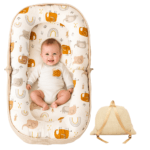Pregnancy is a transformative journey filled with excitement, anticipation, and a fair share of challenges, particularly when getting a good night’s sleep. As your body adapts to accommodate your growing baby, finding a comfortable sleeping position can become increasingly difficult. Enter the pregnancy pillow—a specialized cushion designed to provide the support and comfort needed for restful sleep. But when is the right time to start using one?
This article will explore the ideal timing for incorporating a pregnancy pillow into your nightly routine. From understanding the types of pregnancy pillows available to recognizing the signs that it’s time to start using one, we’ll guide you through everything you need to know to enhance your sleep quality and overall comfort during pregnancy. Prioritizing your rest is crucial; with the right pillow, you can navigate these changes quickly and gracefully.
About Pregnancy pillows

Pregnancy pillows are specially designed cushions that provide support and comfort to pregnant women, helping them achieve restful sleep as their bodies change and grow. These pillows come in various shapes and sizes, each tailored to address specific needs and preferences.
The most common types of pregnancy pillows include full-body, wedge, and C-shaped or U-shaped pillows. Full-body pillows, often in a straight or flexible design, support the entire body, allowing pregnant women to find a comfortable position. Wedge pillows are smaller, more compact options that can be placed under the belly, behind the back, or between the knees to alleviate pressure and provide targeted support. C-shaped and U-shaped pillows are versatile, enveloping the body to support multiple areas simultaneously, including the head, neck, back, and legs.
When choosing a pregnancy pillow, it’s essential to consider the materials and features. Hypoallergenic materials are ideal for those with sensitivities, and washable covers are a practical choice for easy maintenance. Some pillows offer adjustable filling to customize the level of support.
Types of Pregnancy Pillows
Understanding the different types of pregnancy pillows and their benefits can help expectant mothers make informed decisions, ensuring they find the perfect pillow to enhance their sleep quality and overall comfort throughout pregnancy.
Full Body Pillows
Full-body pillows are long, often extending from head to toe, and provide comprehensive support to the entire body. These pillows can be straight or flexible, allowing pregnant women to wrap them around their bodies for maximum comfort. They help alleviate pressure on the back, hips, and belly, making finding a comfortable sleeping position easier.
Wedge Pillows
Wedge pillows are small, triangular cushions designed to provide targeted support. They can be placed under the belly, behind the back, or between the knees. These pillows help alleviate specific discomforts, such as back pain or acid reflux, by providing the necessary elevation and support.
C-shaped and U-shaped Pillows
C-shaped and U-shaped pillows are versatile, enveloping the body to support multiple areas simultaneously. The C-shaped pillow supports the head, neck, back, and legs, while the U-shaped pillow wraps around both sides of the body, offering full support. These pillows help maintain proper alignment and reduce the need for multiple pillows.
Read Know about: Top Tips How to Sleep with a Pregnancy Pillow
Materials and Features to Consider
Hypoallergenic Materials
Hypoallergenic materials are essential for those with allergies or sensitivities. They prevent allergic reactions and ensure a safe and comfortable sleep environment.
Washable Covers
Pregnancy pillows with washable covers are practical for maintaining cleanliness and hygiene. Removable, machine-washed covers make it easy to keep the pillow fresh and free from dust and allergens.
Adjustable Support
Some pregnancy pillows offer adjustable filling, allowing you to customize the level of support. This feature is beneficial for accommodating changes in comfort needs as the pregnancy progresses.
Common Pregnancy Sleep Issues

Back Pain
As the baby grows, the added weight can strain the lower back, leading to discomfort and pain. Pregnancy pillows help support the back and alleviate pressure.
Hip Pain
The increased pressure on the hips from the growing belly can cause pain and discomfort. Properly positioned pregnancy pillows can help reduce this pressure and provide relief.
Difficulty Finding a Comfortable Sleeping Position
As the pregnancy progresses, finding a comfortable sleeping position becomes more challenging. Pregnancy pillows provide the necessary support to help expectant mothers find a position that promotes restful sleep.
Swelling and Leg Cramps
Swelling in the legs and feet and leg cramps are common during pregnancy. Elevating the legs with a pregnancy pillow can help reduce swelling and alleviate cramps.
Acid Reflux
Hormonal changes and the growing uterus can contribute to acid reflux. Elevating the upper body with a wedge pillow can help prevent acid reflux and promote better digestion.
The Relationship Between Pregnancy and Pillows
Alleviating Physical Discomfort
- Back, Hip, and Leg Support: Reduce strain and pain by providing targeted support to growing areas.
- Pressure Reduction: Promote better alignment and alleviate pressure on sensitive areas.
Enhancing Sleep Quality
- Comfortable Positions: Help maintain side sleeping, which is recommended for better blood flow and reduced organ pressure.
- Improved Rest: Enable pregnant women to find and sustain comfortable sleeping positions, enhancing overall sleep quality.
Addressing Common Pregnancy Issues
- Swelling and Leg Cramps: Elevate body parts to reduce swelling and alleviate cramps.
- Acid Reflux: Elevate the upper body to prevent acid reflux and improve digestion.
Psychological Comfort and Relaxation
- Security and Well-being: Offer additional support and cushioning, creating a sense of security.
- Peaceful Sleep: Help expectant mothers relax and sleep more peacefully by feeling well-supported.
Supporting Postpartum Recovery
- Continued Support: Provide comfort and support during postpartum recovery.
- Breastfeeding Aid: Support the back and arms during feeding sessions, making breastfeeding more comfortable.
When should you start using a pregnancy pillow?
The decision of when to start using a pregnancy pillow is personal and depends on individual comfort needs and the progression of pregnancy symptoms. Listening to your body and addressing discomfort early can help you determine when to introduce a pregnancy pillow into your sleep routine, ensuring a more comfortable and restful pregnancy experience.
First Pregnancy
Determining when to start using a pregnancy pillow hinges mainly on how your body adapts throughout each trimester of pregnancy. Many women may not feel the immediate need for a pregnancy pillow in the early stages, particularly the first trimester. Early pregnancy symptoms such as nausea, frequent urination, and general discomfort may impact sleep, but these typically don’t necessitate the use of a specialized pillow just yet. However, some may find relief from minor discomforts using a small wedge pillow to support specific areas like the back or abdomen.
Second Trimester
As pregnancy progresses into the second trimester, the growing belly noticeably affects sleep quality. This is often the optimal time to consider incorporating a pregnancy pillow into your routine. These pillows are designed to support the abdomen, back, and hips, helping to alleviate pressure and maintain a more comfortable sleeping position. Side sleeping becomes increasingly recommended during this stage to improve blood circulation to the fetus and reduce the strain on internal organs.
Third Trimester
By the third trimester, the physical demands of pregnancy are more pronounced. The increased weight and size of the belly can lead to backaches, hip pain, and difficulty finding a comfortable sleeping position. A full-body or U-shaped pregnancy pillow can offer comprehensive support, cradling the entire body and relieving these discomforts. Many women find that using a pregnancy pillow during this final trimester significantly enhances their ability to rest comfortably, contributing to overall well-being as they prepare for childbirth.
How do I know if I need a pregnancy pillow?
Knowing if you need a pregnancy pillow depends on your comfort and sleep quality. Pregnancy pillows are designed to support your changing body and alleviate discomfort. Here are some signs you might need one:
- Difficulty Sleeping: If you find it hard to get comfortable and sleep through the night, a pregnancy pillow can help by providing support to your belly, back, and hips.
- Back Pain: Many pregnant women experience back pain due to the extra weight and shift in their center of gravity. A pregnancy pillow can offer relief by maintaining proper spine alignment.
- Hip and Pelvic Pain: As your hips widen and your body prepares for childbirth, you might experience hip and pelvic pain. A pregnancy pillow can provide cushioning and support to these areas.
- Swelling: If you notice swelling in your legs and feet, elevating them with a pregnancy pillow can improve blood circulation and reduce discomfort.
- General Discomfort: If you feel uncomfortable or restless, a pregnancy pillow can offer support and help you feel more secure and relaxed.
How to Choose the Right Pregnancy Pillow?
Choosing the right pregnancy pillow is crucial for comfort during pregnancy. First, consider the shape: C-shaped pillows support the head, belly, back, and knees, while U-shaped pillows offer support on both sides, making them ideal for side-switchers. Wedge pillows are compact and perfect for targeted belly or back support, and J-shaped pillows have a flexible design that supports the head, abdomen, and knees. Another important factor is size; ensure the pillow fits your bed and leaves enough space for you and your partner.
Material matters, too. Hypoallergenic covers are beneficial if you have allergies, and you can choose from memory foam for firmness, polyester for softness, or microbeads for adjustability. Ensure the pillow offers adequate support for your belly, back, hips, and legs. Look for a pillow with a removable, machine-washable cover for easy cleaning. While price is a consideration, a quality pillow can provide long-term comfort. Lastly, read reviews from other pregnant women to find the most recommended options. Considering these factors will help you select a pregnancy pillow that enhances your comfort and sleep quality during pregnancy.
What Can I Use Instead of a Pregnancy or Maternity Pillow?

If you don’t have a pregnancy or maternity pillow, there are several alternatives you can use to achieve similar comfort and support:
- Regular Pillows: Use multiple standard pillows to support different areas of your body. Place one between your knees, another under your belly, and one behind your back for comprehensive support.
- Body Pillow: A long body pillow can provide similar support to a pregnancy pillow, helping to align your spine and relieve pressure points.
- Foam Wedges: Foam wedges can be placed under your belly or behind your back to provide targeted support and reduce strain.
- Rolled-Up Towels or Blankets: Roll up towels or blankets to create makeshift support for your belly, back, or legs.
- Memory Foam Cushions: These can be placed strategically to relieve pressure and provide needed comfort.
What Can You Do with a Pregnancy or Maternity Pillow After Your Baby Arrives?
After your baby arrives, your pregnancy or maternity pillow can still be handy:
- Postpartum Support: Use the pillow to support your body as it recovers from childbirth. It can help alleviate discomfort and provide support while sitting or lying down.
- Breastfeeding Aid: A pregnancy pillow can serve as a nursing pillow, providing support for your baby and making breastfeeding more comfortable by reducing strain on your arms and back.
- Infant Support: Use the pillow to prop up your baby during supervised tummy time or when they’re learning to sit.
- Lounge Pillow: The pillow can be repurposed as a comfortable lounging cushion for reading, watching TV, or relaxing.
- Pillow Fort: For fun and creative use, transform it into part of a pillow fort for your older children or yourself.
Tips for Using a Pregnancy Pillow Effectively
- Choose the Right Type of Pillow
Select a pregnancy pillow that suits your specific needs, whether a full-body, wedge, C-shaped, or U-shaped pillow.
- Position the Pillow Correctly
Place the pillow to support areas of discomfort, such as under your belly, between your knees, or along your back.
- Support Side Sleeping
Use the pillow to encourage side sleeping, recommended during pregnancy for optimal blood flow and reduced pressure on organs.
- Adjust for Comfort
Experiment with different positions and adjustments to find the most comfortable setup. You may need to reposition the pillow as your pregnancy progresses.
- Combine with Other Pillows
Use additional regular pillows to support your head, neck, or legs.
- Keep the Pillow Clean
To maintain hygiene, wash the pillow cover regularly. Check whether the pillow itself is washable or requires spot cleaning.
- Fluff and Maintain the Pillow
Fluff the pillow regularly to maintain its shape and supportiveness. Some pillows require occasional adjustments or refilling.
- Use During Daytime Rest
Use the pregnancy pillow during naps or rest daily to provide consistent support.
Continue using the pillow after delivery to support postpartum recovery and make breastfeeding more comfortable.
- Listen to Your Body
Pay attention to how your body feels, and adjust the pillow as needed to ensure maximum comfort and support.
FAQ
Are pregnancy pillows safe?
Yes, pregnancy pillows are safe when used as directed. They are designed to provide support and alleviate discomfort during pregnancy. Always ensure the pillow is appropriately positioned to avoid any strain or pain.
Do pregnancy pillows help with sleep?
Many pregnant women find that pregnancy pillows significantly improve their sleep quality by providing the necessary support to reduce discomfort and promote better alignment. However, individual experiences may vary.
Can I travel with my pregnancy pillow?
Some pregnancy pillows, particularly smaller ones like wedge pillows, are travel-friendly. For larger pillows, consider travel-sized versions or alternative ways to achieve support while traveling.
Can I use a regular pillow instead of a pregnancy pillow?
You can use regular pillows to achieve similar support by placing them strategically under your belly, between your knees, and behind your back. However, pregnancy pillows are specifically designed to provide optimal support and may offer better comfort.
How do I care for my pregnancy pillow?
Most pregnancy pillows come with removable and washable covers. Check the care instructions to see if the pillow can be machine-washed or requires spot cleaning. Regularly fluff the pillow to maintain its shape and support.
Conclusion
Pregnancy pillows provide essential support and comfort during pregnancy, especially from the second trimester onward. They alleviate discomfort, promote better sleep, and come in various types like full-body, wedge, C-shaped, and U-shaped pillows. Regular pillows can serve as alternatives if you don’t have a pregnancy pillow. After childbirth, these pillows remain useful for postpartum support, breastfeeding, and lounging. Choosing the right pillow and using it effectively enhances comfort and well-being, making a significant difference throughout pregnancy and beyond.















